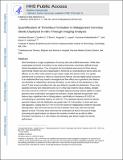| dc.contributor.author | Brown, Jonathan | |
| dc.contributor.author | O'Brien, Caroline C. | |
| dc.contributor.author | Lopes Jr, Augusto Celso de Araujo | |
| dc.contributor.author | Kolandaivelu, Kumaran | |
| dc.contributor.author | Edelman, Elazer R | |
| dc.date.accessioned | 2020-07-27T19:08:48Z | |
| dc.date.available | 2020-07-27T19:08:48Z | |
| dc.date.issued | 2018-04 | |
| dc.date.submitted | 2018-02 | |
| dc.identifier.issn | 0021-9290 | |
| dc.identifier.uri | https://hdl.handle.net/1721.1/126400 | |
| dc.description.abstract | Stent thrombosis is a major complication of coronary stent and scaffold intervention. While often unanticipated and lethal, its incidence is low making mechanistic examination difficult through clinical investigation alone. Thus, throughout the technological advancement of these devices, experimental models have been indispensable in furthering our understanding of device safety and efficacy. As we refine model systems to gain deeper insight into adverse events, it is equally important that we continue to refine our measurement methods. We used digital signal processing in an established flow loop model to investigate local flow effects due to geometric stent features and ultimately its relationship to thrombus formation. A new metric of clot distribution on each microCT slice termed normalized clot ratio was defined to quantify this distribution. Three under expanded coronary bare-metal stents were run in a flow loop model to induce clotting. Samples were then scanned in a MicroCT machine and digital signal processing methods applied to analyze geometric stent conformation and spatial clot formation. Results indicated that geometric stent features play a significant role in clotting patterns, specifically at a frequency of 0.6225 Hz corresponding to a geometric distance of 1.606 mm. The magnitude-squared coherence between geometric features and clot distribution was greater than 0.4 in all samples. In stents with poor wall apposition, ranging from 0.27 mm to 0.64 mm maximum malapposition (model of real-world heterogeneity), clots were found to have formed in between stent struts rather than directly adjacent to struts. This early work shows how the combination of tools in the areas of image processing and signal analysis can advance the resolution at which we are able to define thrombotic mechanisms in in vitro models, and ultimately, gain further insight into clinical performance. | en_US |
| dc.description.sponsorship | NIH (Grant R01 GM-49039) | en_US |
| dc.language.iso | en | |
| dc.publisher | Elsevier BV | en_US |
| dc.relation.isversionof | http://dx.doi.org/10.1016/j.jbiomech.2018.01.044 | en_US |
| dc.rights | Creative Commons Attribution-NonCommercial-NoDerivs License | en_US |
| dc.rights.uri | http://creativecommons.org/licenses/by-nc-nd/4.0/ | en_US |
| dc.source | PMC | en_US |
| dc.title | Quantification of thrombus formation in malapposed coronary stents deployed in vitro through imaging analysis | en_US |
| dc.type | Article | en_US |
| dc.identifier.citation | Brown, Jonathan et al. "Quantification of thrombus formation in malapposed coronary stents deployed in vitro through imaging analysis." Journal of Biomechanics 71 (April 2018): 296-301 © 2018 Elsevier Ltd | en_US |
| dc.contributor.department | Massachusetts Institute of Technology. Institute for Medical Engineering & Science | en_US |
| dc.relation.journal | Journal of Biomechanics | en_US |
| dc.eprint.version | Author's final manuscript | en_US |
| dc.type.uri | http://purl.org/eprint/type/JournalArticle | en_US |
| eprint.status | http://purl.org/eprint/status/PeerReviewed | en_US |
| dc.date.updated | 2019-10-09T18:09:41Z | |
| dspace.date.submission | 2019-10-09T18:09:42Z | |
| mit.journal.volume | 71 | en_US |
| mit.metadata.status | Complete | |
